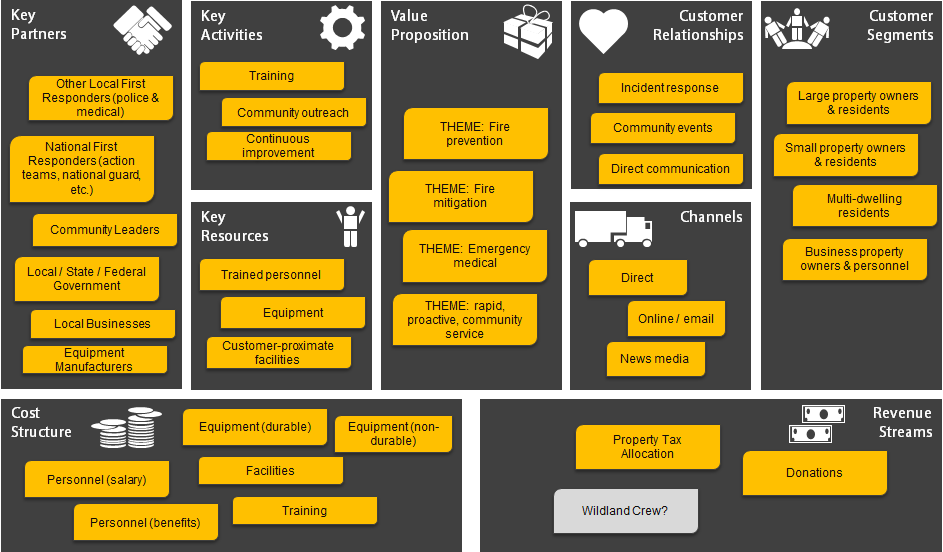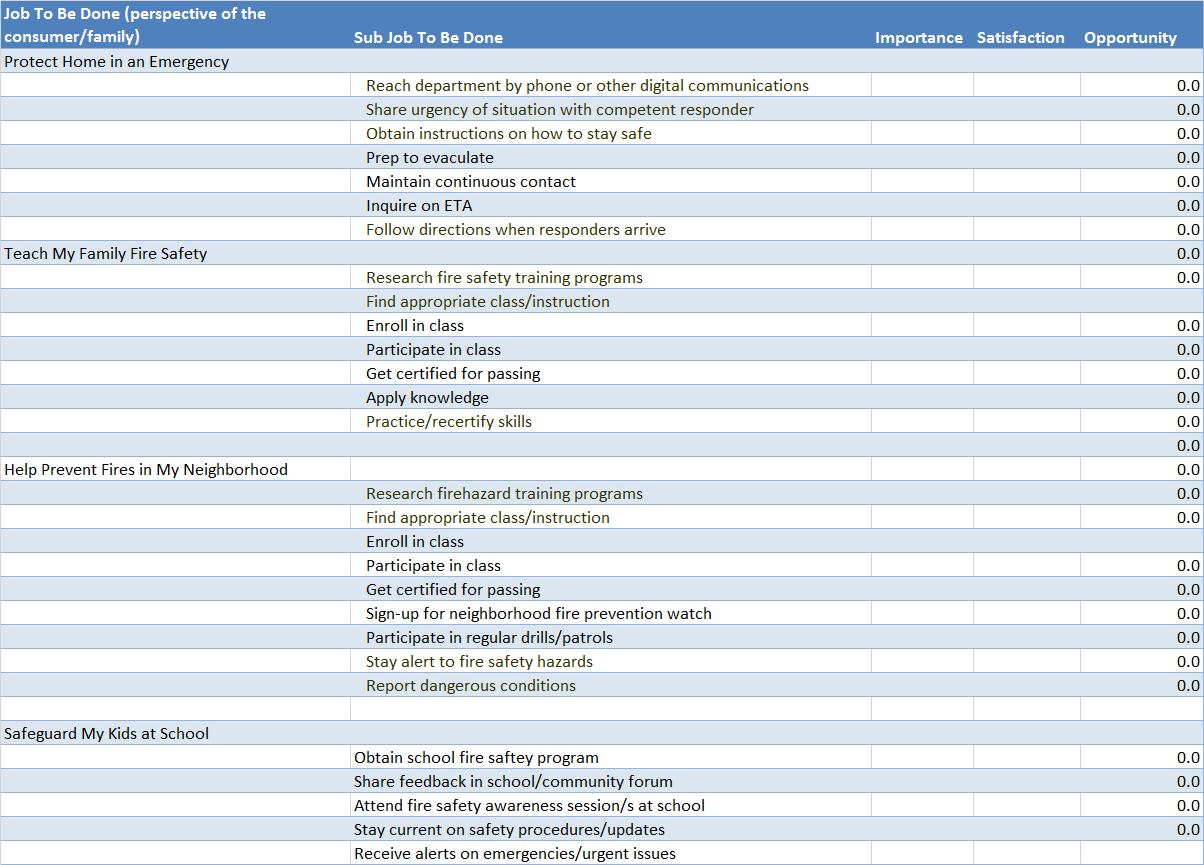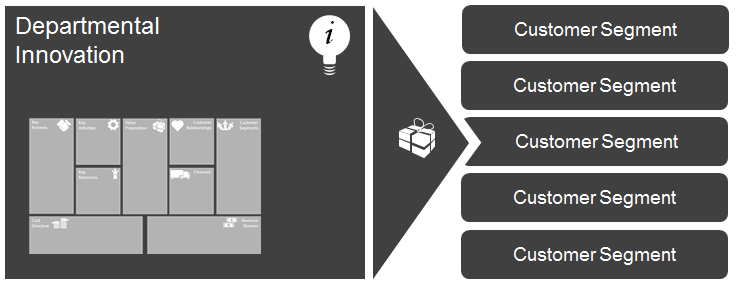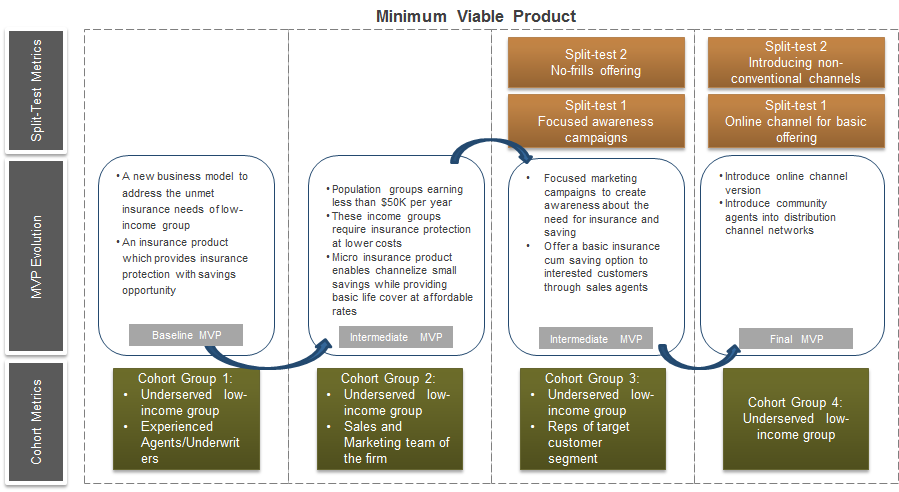Please see the attached point of view related to a very hot topic / challenge for most carriers today: how to generate sustainable revenue growth through new products. By tackling this problem holistically (new product ideas -> product configuration & sales launch -> product tracking & customer engagement) AND using the BMI toolkit for truly powerful implication analysis, any carrier will likely see tangible results.
Author Archives: Sigvard Bore
Design Thinking Innovation Nugget: ENVIRONMENT
After completing a fairly detailed overview & training session (including a visit to Stanford’s d. School), I came away with several new tools that will be added to the BMI toolkit. So, without further delay, let’s get into the first of two key categories of tools that most definitely add tremendous value to today’s innovation process.
Environment & Physical Space
Whether in the Idea Generation or Commercialization Analysis phase of the Innovation Lifecycle, participants are likely to find themselves in a group setting to discuss / debate / ideate. For the vast majority of us, that usually means some conference room or hotel conference facility somewhere. Until my visit to the d. School at Stanford, I had pretty much accepted this as one constant that really didn’t warrant much extra attention. Sure, we could improvise by using flip charts, post-it notes, and rearranging the tables a bit, but most creativity would be unlocked by other facilitation techniques – carefully planning breakout groups, six thinking hats role-play, pre-mortem, etc.
I now believe we have been selling ourselves short by not taking advantage of a truly innovation-friendly environment. Although you can hopefully gain some perspective of what that means by looking at the pictures below, I think it is hard to fully appreciate the true impact it has until someone explains it to you (or to me, as John and Erin did)… NOTE: what follows is more about group discussion and dynamics than a simple “set direction” or status meeting. Think about the last group meeting you had in the typical conference room – someone presented or someone was urging a group discussion usually aided by slides or a handout. How many people truly participated? How much original thought surfaced beyond what was already on the slides? Did anyone really step up and help the content evolve? Why is that?
The fact remains that most conference rooms are designed for presentation, or are just a slightly more group-friendly version of our desks. Often, attendees are automatically in one of several modes: friend or colleague (want to be supportive), subordinate (don’t want to comment as it might be seen as criticism), boss (concerned about steering conversation in one direction over another). To make matters more challenging, it is not easy to share “rough” or “unpolished” thoughts – imagine going to the whiteboard (often at the front of the room) and sketching some doodles trying to explain your thoughts right next to the projected presentation that someone has spent the last month making perfect? Even if a few participants do manage to overcome the typical barriers, do the majority of people contribute? Likely not, and that means we are nowhere near our innovation capacity.
NEW DEFINITION ALERT!
Innovation Capacity: the total number of creative minds in a given setting… addendum: EVERY person has a creative mind, but some have yet to be “unlocked”… addendum2: all human children start out with a completely unlocked creative mind, but are slowly taught to keep that dangerous thing under lock and key with only scant visitation rights
So what are some of these powerful environment considerations that you can (hopefully) see in the pictures?
Nothing too rigid
Easily movable parts (chairs, tables, walls, whiteboards, etc.)
Looks like a work in progress
Whimsical additions that can be used as aids
Lots of medium upon which to sketch (ideally, easy to erase as well)
An area for building prototypes (both tech and physical)… more to come on this topic in the next blog post
A “reset” guide for when done using the space – essentially how to clear the canvas
Having seen all these elements in sum total, I can definitely see how they collectively add to the feeling of “creative confidence” (Google it) that Design Thinking encourages.
Does this mean our usual corporate working space needs to go the way of the dodo? No, but it certainly does open up some valuable lessons about what we can do different if we are actually trying to encourage innovative thinking. In fact, based on what I saw first-hand at Stanford, I would strongly endorse that EVERY company interested in thriving in the 21st century and beyond should dedicate some of its current facilities to the ideal innovation environment principles. It can serve as both a training facility and as an innovation-focused conference center. It can also serve as a model of what to strive for if those perfect circumstances cannot be replicated in total – we actually “morphed” a traditional conference room into something more conducive by applying some of these principles.
Back in the Innovation Swing of Things!
What a great way to come up for a breath of innovation air after spending the past 18 months on a more traditional, large-scale transformation at a major insurance carrier. What exactly was this event? A multi-day session focused on Design Thinking, including a visit to the Stanford school itself!
You can expect another post shortly about the various learnings and relevance to BMI of design thinking. To be sure, there are some new tools that are going to be added to the toolkit!
http://dschool.stanford.edu/our-point-of-view/
And a few pictures from the trip (more to come):
A classic catalyst for new thinking…
… and if all else fails to expand the mental horizons, the Stanford golf course stands ready to help =)
BMI Applied to First Responders (start)
Working with the local fire chief in the Falcon district (in Colorado Springs area, and one of several local fire departments very much involved battling this year’s massive Black Forest fire), we have shared the following two BMI components to facilitate the discussion focused on how BMI might actually help – see how using a business model mindset coupled with a “jobs” focus could potentially identify new ways for the fire department to be more successful, grow, and achieve its longer term goals.
Business Model Canvas (current state)
Jobs To Be Done (from a district resident perspective related to first responders)
Although we wont be setting any speed records for delivery here (this is being done in our spare time), we feel pretty confident we can identify several new areas for the local fire department to make meaningful improvements in the business of running their department. A couple of key objectives that are front & center for this effort:
- New funding sources (predictable being key)
- New ways of working with local community (e.g. tapping into HOAs more)
- Ballot planning (multi-year)
We will also we reaching out to other local fire departments around the country, and welcome your feedback/suggestions!
A New Business Model for First Responder Firefighters?
Having just gone through the ordeal of the Black Forest Fire, including being evacuated for 8 days without being allowed back to check on house or property, it made me wonder if even something as stalwart as our first responder firefighter business model could benefit from some BMI thinking.
To set the stage, let me first say how AMAZING these heroes are in what they do. They managed to save all the homes in our development, despite the 150 ft firestorm that came barreling towards / into our little bit of paradise. Take a look at what the crew faced below:
And here is a sampling of the aftermath:
So, clearly these guys faced the dragon and eventually beat it down. However, that does not mean there isn’t room for improvement. Furthermore, I wonder if these heroes ever get the chance to engage management consultants to take a fresh look at what they do, or more specifically, HOW they run their business / underlying business model. DISCLAIMER: we are not going anywhere near the actual fire fighting – these guys have that stuff nailed – but we want to take a look at the some of the stuff surrounding their heroic core.
In the coming weeks, we hope to debate this topic, put pen to paper, and hopefully even come up with something that could be considered useful. We will also pay very close attention to this business model problem from a not-for-profit perspective and how that manifests itself into business model design.
Don’t Just be a Passenger on the Train of Your Traditional Value Chain
Aside
Had a discussion tonight with Helen focused on the firm of the 21st century, and this notable quotable came up:
“Don’t just be a passenger on the train of your traditional value chain”
Departmental Innovation – Big Change, Tiny Footprint
One of the concerns we have heard time and time again when discussing innovation with established companies is the resistance to change from other areas of the business. Sure, the department or business unit would love to try something different, but they are convinced that doing anything too dramatic would inevitably be crushed by some other power in the same company.
This challenge is hardly anything new, and has been a major change management concern for decades. However, when it come to business model innovation, there is a clever way to contain the magnitude of outward-facing change, while at the same time allowing for substantial change “behind the curtain.”
Departmental innovation usually takes the following form:
- Provide something new (the “what” – usually a new offering or service)
- Deliver the offering or service in a new, innovative way (the “how” – ideally with an optimized business model)
It is critical to recognize that BOTH are equally important to ensure full value delivery to the customer / constituent group, and that both will likely need to evolve as validated learning happens. That said, of the two forms, the department has most control over its own business model, with limited external stakeholder interference. So how then can a department contain the amount of change associated with the offering itself?
Simply put, don’t try wide-scale rollout all at once. Instead, leverage the “wedge” principles – find a needy segment with truly underserved opportunity and one that would likely sing your praises should you succeed (see “The Wedge” post here for more details). Let a small success story be your momentum builder, while keeping the amount of stakeholder management very focused on just that initial segment… there is no need to convince everyone across the enterprise all at once that your new innovation is worthwhile. Then, let your first few successes be the mechanism through which you turn the tide of enterprise thinking.
Bottom line, departments within a large structure DO actually have the ability to innovate, and innovate substantially. But, do it smartly, where the biggest change happens behind the scenes. The “external” footprint starts small and only expands with success as its driver.
The Wedge
Assume the following:
- New innovation idea has been qualified, with clear value and growth hypotheses
- Target customer segments have been identified
- The business model has been designed to support the optimal delivery of the idea
- Innovation accounting principles have been employed to determine the appropriate metrics to track
Now the challenge becomes how to validate the idea (WHAT) and the business model behind it (HOW). Enter the “Wedge” approach to experimentation and deployment…
Much as the name implies, a wedge approach to experimentation starts small – you insert the tip of the wedge where it is most likely to have positive effect (e.g. the door jam, or parallel to the seams in a log). In business terms, pick a customer segment that has the most underserved opportunity, and ideally is one that could have ripple effects across other segments when these needs are met. Put another way, pick a high-profile segment where success is very likely to build momentum.
It is rare that an actual wedge reaches its ideal state without a few taps – the experimentation version of the wedge works the same way. Given that this is early stage experimentation, start by validating the fundamentals of the idea – the value and growth hypotheses – with direct segment interaction. Note that traditional metrics (e.g. profitability, growth, retention, etc.) are NOT relevant for this early stage. Assuming both can be validated, then progressively add more detailed idea validation with the target segment, making adjustments at every stage based on validated learning. The key principle to abide by is to front-load the biggest, most uncertain assumptions early in the experimentation process. Using Ries’ Minimum Viable Product (MVP) principles is an excellent way to put this theory into practice (see illustration below).
So assuming the commercial viability gets validated, and now the time comes to deploy… what do you do? You keep using the wedge approach! This method is just as relevant for deployment as it is for experimentation.
Patterns’ Power to Inspire
There is a broad spectrum of solutions helping companies identify new innovation ideas, from a departmental suggestion box, to studying the best practices of others, even to the vaunted halls of big data analytics. However, I wanted to throw an often underutilized source into the mix – business model patterns. What is a business model pattern? As Osterwalder & Pigneur define in their Business Model Generation book, business model patterns are similarities in how the individual business model building blocks behave (with similar characteristics and/or arrangements).
There are plenty of patterns to choose from – OPEN, Long Tail, FREEMIUM, SaaS, etc. – and each has its own characteristics. For example, the FREEMIUM pattern has unique Revenue Streams and Customer Relationships behavior. Could these be leveraged by a shared service function trying to redesign its future operating model? Maybe. Can the pattern inspire one of the function executives to put her own unique twist on the way they manage relationships, or secure their funding? You bet!
The power of patterns’ ability to inspire innovation was illustrated in a recent client engagement. We used a business model pattern presentation as a lead-in to a focused business model design session. The executives in attendance were asked to make notes of key building block features that they found interesting for each pattern discussed, and which might have relevance for their area. As we then moved into the actual business model design activity, it became clear that the participants had not only identified new possible variations on their offerings (the WHAT), but also specific business model changes they wanted to make to deliver that value (the HOW). Furthermore, they had already started to make the connection between the new ideas and their specific areas (i.e. made a preliminary implication analysis).
So, although ANY solution that leads to innovation is a step in the right direction, executives who don’t add business model patterns to their idea generation arsenal may be missing a relatively simple, golden nugget.
Getting started
Given the very positive interest we have received with our new Business Model Innovation (BMI) offering, we have decided it was time to open a blog outlet focused on the topic and our experiences taking this thing to market. Stay tuned for regular updates and hopefully plenty of thought-provoking perspectives – most should be directly or indirectly related to BMI.





















